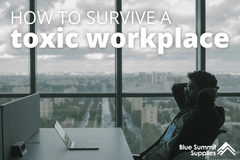“Mindfulness” isn’t just a buzzword. Science supports the practice of mindfulness and being present at work as a way to reduce stress, increase productivity, and improve mood. According to Mindful.org, those who practice mindfulness and meditation consistently and over long periods of time enjoy a series of benefits:
- More confidence
- Fewer symptoms of depression and anxiety
- Greater attention span
- Reduced symptoms of binge eating
- Higher satisfaction with life
- Improved optimism and self-control
- Overall improved physical and emotional well-being
- Reduced symptoms of stress and improved stress tolerance
- Improved empathy
In practice, businesses will see these benefits translate to employees being calmer and more positive during customer and client interactions, teams being more productive and collaborative, and overall reduced turnover and greater engagement. With a strong mindfulness practice, employees will likely feel the benefits of being ‘more zen at work’ with a better work-life balance and better focus day to day.
The Greater Good Science Center at UC Berkeley emphasizes the importance of mindfulness at work by stating, “We have entered what many people are calling the ‘attention economy.’ In the attention economy, the ability to maintain focus and concentration is every bit as important as technical or management skills. And because leaders need to absorb and synthesize a growing flood of information in order to make good decisions, they’re hit particularly hard by this emerging trend. The good news is you can train your brain to focus better by incorporating mindfulness exercises throughout your day.”

Just like physical exercise is crucial for a healthy, strong body, mental and emotional wellness are easier to achieve through practice. This kind of focus on mental health and wellness is increasingly important in an age where people are being asked to not just take on more tasks in the office, but often to uproot from a focused office space to working from home while also doing distance learning with their kids and navigating other challenges. This new way of working can be overwhelming for many.
The New York Times notes, “One way mindfulness can help is simply by allowing us to improve our focus. When we constantly flit from one task to another, the quality of our work can suffer. By practicing mindfulness — simply coming back to the present moment over and over again — we can train ourselves to become more focused…The goal of mindfulness isn’t to stop thinking, or to empty the mind. Rather, the point is to pay close attention to your physical sensations, thoughts and emotions in order to see them more clearly, without making so many assumptions, or making up stories.”
So how can you tap into this this powerful practice?
What Does Mindfulness Look Like? How to be Present at Work
Mindfulness-based and mindfulness-improving activities can take several forms, including yoga, tai chi, qigong, centering prayer, chanting, and meditation. Participating in these activities outside of work can help shape your overall mindfulness and bring the benefits into the office with you every day and help you reach the benefits in your professional endeavors as well as your personal life. Most people – busy with life outside of work including family, continuing education, and other wellness pursuits – don’t always have the time to invest in full-fledged mindfulness training in their off time.
Many companies have realized the benefits of investing in the mental and emotional wellness of their employees and are implementing mindfulness team building activities and corporate mindfulness programs that give their employees a chance to build a mindfulness practice on the clock.
Some examples include:

Zen pods
Some of the most mindful-focused workplaces have built zen into their work culture by offering office or booths for employees to take breaks in as needed. These pods often include soft seating, noise canceling headphones for listening to meditation or music, or other tools to help employees practice being present at work.

Yoga classes
Plenty of offices offer on-site yoga classes or memberships to gyms that offer group classes and personal training. The benefits of movement – and of yoga in particular – have been linked to greater mindfulness, reduced stress, less anxiety, better pain management, and more, which is why so many companies have invested in encouraging this kind of wellness for their employees. In the current age of increased distance work and more remote employees, some workplaces are transitioning to inviting employees to yoga classes on Zoom during a lunch hour or offering memberships to online yoga studios.

Massage therapy
It’s not uncommon for companies to bring in massage therapists for chair massages during the week to offer employees a chance to take 10-15 minutes practicing relaxation and being present at work. With increased social distancing, employers can pivot to offering employees tools like foam rollers, trigger point massage tools, and massage balls to use at home for a more tactile mindfulness practice.

Mindfulness retreats
Companies with spread-out teams often have annual or semi-regular retreats that bring the whole company together for team-building and better collaboration across otherwise disparate business units. Some companies have focused on bringing elements of wellness and mindfulness to these retreats with speakers, yoga classes, meditation spaces, and more. While fewer groups are gathering in physical spaces, companies can still host mini-retreats in digital spaces that can offer the same speaker-led seminars that can introduce or grow mindfulness in a corporate culture.

Book club
Books like The Power of Now and 10% Happier are great introductions to mindfulness and offer practical techniques to build mindfulness. Employers can purchase the book for their teams (print or digital) and employees can be invited to in-person or online book clubs to discuss what they learned and what they’ve tried that’s worked for them. These conversations can even take place on a company intranet, Microsoft Teams channel, or other employee communication space.
Mindfulness-Based Stress Reduction Exercises
If you’re looking for ways to take mindfulness into your own hands and be more zen at work, these brief mindfulness exercises can help improve your mood, focus, and calm throughout the day.

Lunch yoga
Taking a yoga break is a great way to practice being present at work. It can help resettle your mind and allow you feel refreshed and recharged for the rest of your day. Even if your company doesn’t offer any work-led yoga options, it’s easy to practice at home or even in your office. YouTube offers plenty of free classes led by professional yoga instructors, and there are apps like Simply Yoga that are easy to download and use on the go. More options means it’s easy to find a lunch-length session to help bring calm to your body and your mind.

Meditation apps
Headspace and Calm are two of the most popular guided meditation apps that allow users to pick from meditation themes and lengths to allow them to grow in their mindfulness and meditation practice.

Body scan
You don’t need any tools to practice this and it’s easy to practice from a desk chair, even for just a few minutes a day. Most body scan practice starts by closing the eyes, taking a few deep breaths, and then focusing on one area of the body at a time, usually starting at the crown of the head or the sols of the feet. Is there tingly in the scalp? Soreness in the ankles? The point is to juts notice how your body is feeling and focus on paying attention to what’s going on in the moment without judgement or rushing to move to whatever is next.

Breath work
One of the most popular breath work exercises for beginners is inhaling for 4-5 seconds and then exhaling for 4-5 seconds while focusing how the breath feels in your nose, throat, lungs, and stomach. During this time, it’s normal for your mind to wander. The most important part of all breathwork and meditation is to notice when your attention is somewhere else and gently bring it back to the moment. Many people start this mindfulness technique by setting a timer for a few minutes and growing their practice from there. Because of its simplicity, it’s an easy habit to start for anyone looking for an easy, beginner-friendly way to be more present at work and throughout the day.

Coloring books
“Adult coloring books” are a popular trend and for good reason. Coloring books help you focus on one activity that connects something tactile with the mind and can help slow down frantic thoughts. They can be a great option for creatives looking for a way to connect with mindfulness.
There are many paths to mindfulness. Whichever mindfulness exercises and traditions you choose to practice, they should help you grow in the ability to practice acceptance, non-judgement, patience, trust, letting go, and other qualities that encourage being present. No matter where you practice mindfulness-building techniques – at home, in the office, before bed, during lunch – the benefits will support you through your workday and beyond.
Want more helpful info like this? Follow us onTwitter, Instagram, and Facebook to stay in the know! If you have any questions or thoughts, comment below or send us an email – Larry loves hearing from you.
 For more informative articles about office supplies, subscribe to our email newsletter!
For more informative articles about office supplies, subscribe to our email newsletter!
Never fear, you won't begin receiving daily sales emails that belong in a spam folder. Instead, we promise a fun weekly roundup of our latest blog posts and great finds from across the web. And if you lose interest, it's always easy to unsubscribe with a single click.









